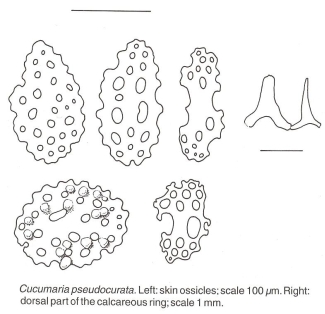Cucumaria pseudocurata is a small species, averaging 1.5 to 3 cm in length. The dorsal side varies from brownish black to light brown to yellowish grey, the ventral side from brown to white. The five bands of tube feet are in single or zigzag rows - the three ventral rows being more robust. There are no tube feet scattered between the rows. As a rule, there are eight equal-sized tentacles and two smaller ventral ones; but occasionally populations have been reported with a large proportion of equal-sized tentacles. This may have been due to misidentification, however. The tips of the tentacles are usually the most darkly pigmented. A genital papilla occurs between two of the dorsal tentacles.
Skin ossicles: oval perforated plates; typically with two central oval holes surrounded by smaller holes. In the southern part of C. pseudocurata's range, its ossicles are large and oval, but towards the north, its ossicles are more narrow and smoother around the edge.
Similar SpeciesIn British Columbia Cucumaria pseudocurata might be confused with Pseudocnus curatus (formerly Cucumaria curata). P. curatus is usually black or dark brown, has 10 equal-sized tentacles, and tube feet scattered on the dorsal side. It is usually found at shallow subtidal or low intertidal - while C. pseudocurata is found at the mid intertidal level, near or among mussels.
To further confuse identifications, Cucumaria pseudocurata is hard to differentiate from Cucumaria vegae from Alaska. In fact, they appear identical to the naked eye. There is a gradual change in the ossicles of C. pseudocurata with latitude, but there is no clear distinction between it and C. vegae. Recent work with the DNA of these two species has confirmed that they are closely related, with only a 2% difference in the DNA between C. pseudocurata in the south and C. vegae in the north. In this type of analysis a difference of greater than 2% would indicate that the two forms were distinct species, 2% or less is not sufficient to separate them. Because these two names are already in the literature, and it is still not clear whether to synonymize them, I have retained them as separate species in this book. For the time being, I would identify a specimen from south of the Queen Charlotte Islands as C. pseudocurata and those from the Queen Charlottes north to the Aleutians as C. vegae.

